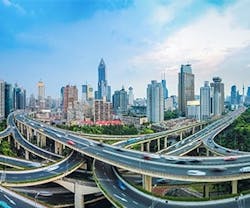In our February issue, we explored the theme of the "Concrete Jungle"—a term that evokes both the grit and energy of vibrant cities and quickens the pulse of urban planners. As the world’s population continues to grow exponentially, a recent United Nations study reveals that half of the world’s population currently lives in an urban area, and by 2050, an additional 2.5 billion will call some kind of concrete jungle their home.
As a result, firms like Atkins are embarking on a new mission to “future-proof” our cities to ensure that they are livable and sustainable for future inhabitants. The firm, led by engineer Stephen Bourne, proposes to run “stress tests” using software that simulates economic and population growth over extended periods. He pleads his case for better urban and master planning to better manage the rapid urbanization of the world’s cities in this video from CNBC.
The idea of making cities sustainable isn’t new to architecture professionals, of course. Initiatives like the Architecture 2030 Challenge aim to tackle the climate change problem head on through the built environment. But making our cities more resilient involves a broader perspective—one that expands “the capacity of individuals, communities, institutions, businesses, and systems within a city to survive, adapt, and grow no matter what kinds of chronic stresses and acute shocks they experience,” as noted by the Rockefeller Foundation’s 100 Resilient Cities (100RC).
According to 100RC, there are seven qualities that make cities resilient (or future-proof):
1.Reflective—using past experience to inform future decisions
2.Resourceful—recognizing alternative ways to use resources
3.Robust—well-conceived, constructed, and managed systems
4.Redundant—spare capacity purposively created to accommodate disruption
5.Flexible—willingness and ability to adopt alternative strategies in response to changing circumstances
6.Inclusive—prioritize broad consultation to create a sense of shared ownership in decision making
7.Integrated—bring together a range of distinct systems and institutions
In spite of the monumental challenges that the future holds, I’m hopeful that a sustainable, resilient future is within our grasp; that through the foresight and diligence of those who shape our communities, we’ll all have a place to call home in the years to come.
About the Author
Robert Nieminen
Chief Content Director
Chief Content Director, Architectural Products, BUILDINGS, and interiors+sources
Robert Nieminen is the Chief Content Director of three leading B2B publications serving the commercial architecture and design industries: Architectural Products, BUILDINGS, and interiors+sources. With a career rooted in editorial excellence and a passion for storytelling, Robert oversees a diverse content portfolio that spans award-winning feature articles, strategic podcast programming, and digital media initiatives aimed at empowering design professionals, facility managers, and commercial building stakeholders.
He is the host of the I Hear Design podcast and curates the Smart Buildings Technology Report, bringing thought leadership to the forefront of innovation in built environments. Robert leads editorial and creative direction for multiple industry award programs—including the Elev8 Design Awards and Product Innovation Awards—and is a recognized voice in sustainability, smart technology integration, and forward-thinking design.
Known for his sharp editorial vision and data-informed strategies, Robert focuses on audience growth, engagement, and content monetization, leveraging AI tools and SEO-driven insights to future-proof B2B publishing.

